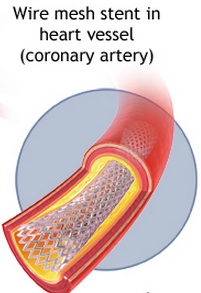What is angioplasty and stenting?
During an angioplasty, the surgeon inflates a small balloon inside a narrowed blood vessel. The balloon helps to widen your blood vessel to improve the blood flow. After widening the vessel with angioplasty, your vascular surgeon sometimes inserts a stent. Stents are tiny metal mesh tubes that support your artery walls to keep your vessels wide open.
Angioplasty and stenting are usually done through a small incision, in your skin, called the access site. The surgeon inserts a long, thin tube called a catheter through this incision. Using X-ray guidance, your physician then guides the catheter through your blood vessels to the blocked area. The tip of the catheter carries the angioplasty balloon or stent.
Angioplasty most often is used to treat peripheral arterial disease (PAD), which is another name for hardening of the arteries supplying blood to your limbs or to organs in your body other than your heart. Angioplasty can also be used, sometimes, to treat narrowed areas in your vessels, which are blood vessels that drain blood out of your limbs or organs and return the blood to your lungs and heart.

Your arteries are normally smooth and unobstructed on the inside, but as you age, plaque can build up in the walls of your arteries. Cholesterol, calcium, and fibrous tissue make up this plaque. As more plaque builds up, your arteries can narrow and stiffen. This process is called atherosclerosis, or hardening of the arteries. Eventually, enough plaque builds up to reduce blood flow through your arteries causing pain or damage to the part of the body that the artery supplies.
Depending upon the particular circumstances, your physician may recommend angioplasty as an alternative to bypass surgery, which also treats narrowed arteries. For certain types of blockages, angioplasty has some advantages when compared to bypass surgery. For example, angioplasty does not require a large incision. Because of this, angioplasty patients usually spend less time in the hospital and recover at home faster than bypass surgery patients. Also, your physician can usually perform angioplasty while you are awake, whereas bypass surgery requires general or regional anesthesia. Nevertheless, in some circumstances, especially for extensive PAD, bypass surgery may be a better option. Your vascular surgeon will help you decide what alternative is best for your particular situation.
